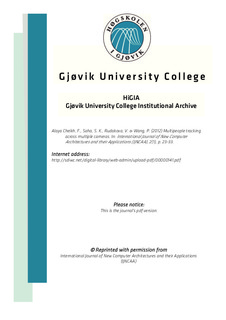Multipeople tracking across multiple cameras
Journal article, Peer reviewed
Permanent lenke
http://hdl.handle.net/11250/142570Utgivelsesdato
2012Metadata
Vis full innførselSamlinger
Originalversjon
Alaya Cheikh, F., Saha, S. K., Rudakova, V. &Wang, P. (2012) Multipeople tracking across multiple cameras. In: International Journal of New Computer Architectures and their Applications (IJNCAA), 2(1), p. 23-33.Sammendrag
Multi-target tracking (MTT) is an active and challenging research
topic. Many different approaches to MTT problem exist, yet there are still
few satisfactory methods of solving multi-target occlusion problem, which
often appears in multi-target tracking task. The application of multi cameras
in most existing researches for multi-target occlusion requires camera
calibration parameters in advance, which is not practical in the case of
outdoor video surveillance. Most of the proposed solutions for this problem
require camera calibration parameters that make them impractical for outdoor
video surveillance applications. To address this problem we propose in this
paper a probabilistic approach, the foremost consideration of which is to
reduce the dependency on camera calibration for multiple camera
collaboration. More robustness on target representation and object tracking
has been ensured by combining multiple cues such as border information of
the object with color histogram, while Gale-Shapley algorithm (GSA) has
been used for finding the stable matching between objects of two or more
camera views. Efficient tracking of object ensures proficient recognition of
target depicting parameters (i.e. apparent color, height and width information
of the object) as a consequence provides better camera collaboration. Initial
simulation results prove the validity of the proposed approach.
Beskrivelse
This is the journal’s version of the article published in International Journal of New Computer Architectures and their Applications (IJNCAA): http://www.sdiwc.net/ijncaa/about-this-journal
